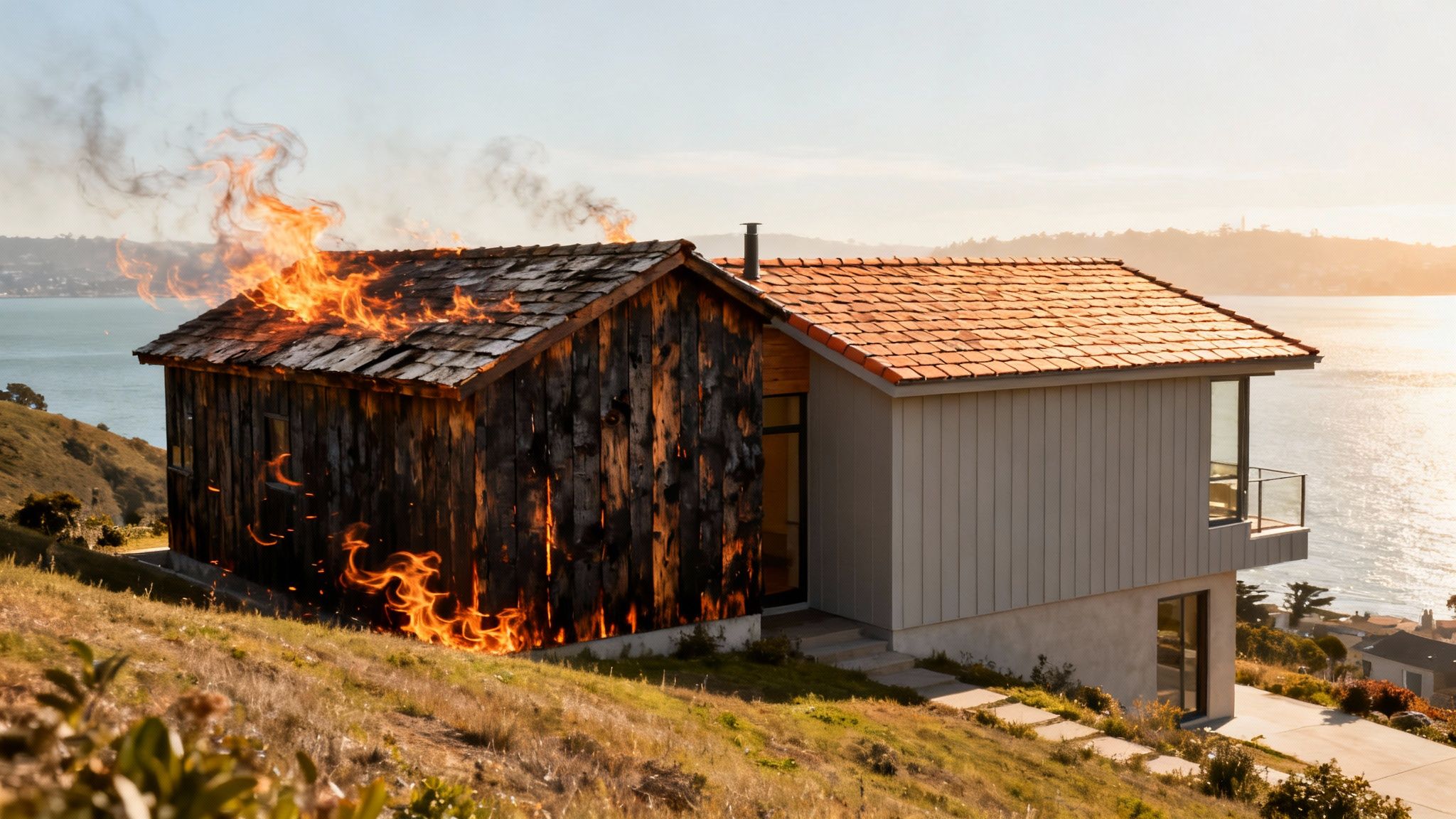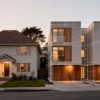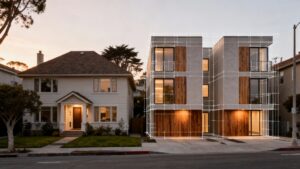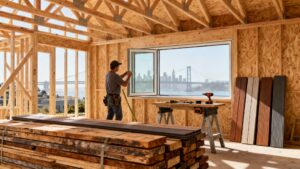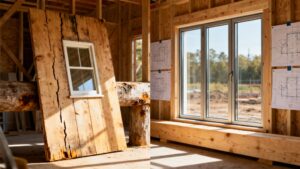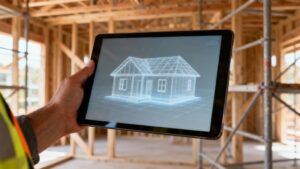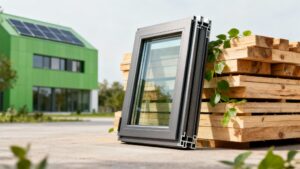Building for tomorrow is about choosing materials that defend your Bay Area home from real threats. It's also about boosting its long-term value. Fire-resistant construction is the new standard for building a resilient property that can handle our region's climate.
This approach gives you critical protection and helps you meet modern insurance demands. Most importantly, it delivers lasting peace of mind.
The New Standard for Bay Area Construction
The conversation around building in the Bay Area has changed. It is no longer just about aesthetics; it’s about resilience. With wildfire risk becoming a year-round reality, builders and homeowners from Berkeley to Oakland are asking how to build homes that last.
This shift comes from a new reality. The Bay Area's geography, with its hillsides and Wildland-Urban Interface (WUI) zones, brings a heavy responsibility. Your choice of building materials is one of the most important decisions you will make.
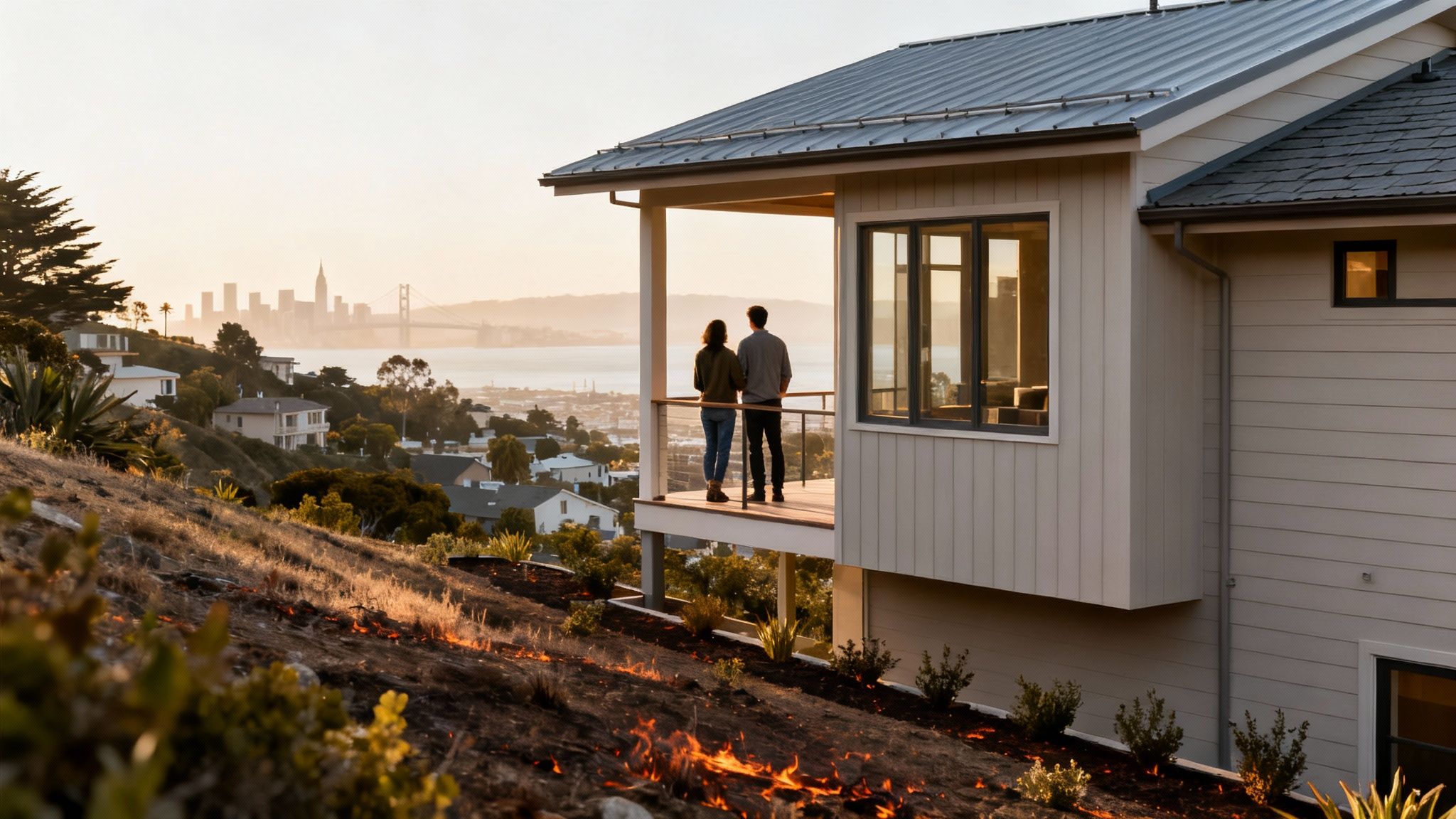
Why Resilience Is the New Priority for Bay Area Homes
Think of fire-resistant construction as a proactive strategy. You are building your home’s first line of defense right into its structure. This mindset focuses on durability and safety against regional risks. Learn more in our guide to what is sustainable building.
This focus on resilience gives you several advantages:
- Enhanced Safety: It provides critical protection for your family against wind-blown embers and intense heat, which cause most home losses during a wildfire.
- Insurance and Code Compliance: Building this way helps you meet strict local building codes and insurance requirements. Carriers are scrutinizing a home's risk profile more closely than ever.
- Increased Property Value: A home built with fire-resistant materials is a more secure, durable, and desirable asset. It often commands a higher resale value.
A Data-Driven Approach to Safety
The value of fire-resistant construction is backed by data. Advanced insurance and hazard mapping tools paint a clear picture of wildfire risk. According to a 2022 First Street Foundation report, nearly 1.2 million properties in California have at least a 1% annual chance of being affected by wildfire.
This guide is your practical roadmap to building a safer home. We'll show how picking the right fire-resistant materials is the smartest investment for your Bay Area property.
Decoding Fire Ratings and Bay Area Building Codes
When you look into fire-resistant materials, you'll see new terms. Phrases like ‘Class A’ rating or ‘non-combustible’ might sound technical, but they're simple. This system grades how well a material can stand up to fire and keep your home safe.
Think of fire ratings like a report card for your building materials. A ‘Class A’ rating is the A+—it means the material provides the best fire resistance available. This framework protects homes in Oakland, Berkeley, and across the Bay Area from embers and heat.
Understanding Fire Resistance Ratings
Fire ratings are given to materials after they go through tests. These tests measure how long they can resist a fire and stop it from spreading. For building exteriors, the most common system uses a letter grade.
Understanding these grades is the first step to making smart choices.
- Class A: This is the top of the line and effective against severe fire exposure. These materials include fiber-cement siding, metal roofing, and tempered glass. They are designed not to ignite or spread a fire.
- Class B: These materials hold up against moderate fire exposure. They still offer good protection but aren't as tough as Class A options.
- Class C: This grade is only effective against light fire exposure. Many standard materials, like untreated wood shakes, fall into this category and are not enough for high-risk areas.
Choosing Class A-rated materials is a key strategy for "home hardening"—making a structure more resistant to wildfire. It's a proactive step that can dramatically boost a home's chances of survival.
What Is a Wildland-Urban Interface (WUI) Zone?
The term Wildland-Urban Interface (WUI) is important if you're building in the Bay Area. A WUI zone is any area where homes are built near lands prone to wildfire. Many communities in the Berkeley and Oakland hills, along with parts of Marin, fit this description.
Homes in WUI zones are at a higher risk and must follow stricter building codes. These rules help create a more resilient community, one house at a time. The goal is to stop a single ember from starting a chain reaction that could endanger a neighborhood.
California Chapter 7A: The Rulebook for WUI Zones
For anyone building in these areas, California's Chapter 7A building code is the rulebook. This code sets the minimum standards for materials and construction in WUI zones to protect homes.
Chapter 7A is a practical safety guide. It gives specific requirements for the most vulnerable parts of a house. This ensures they can resist ignition from embers, which can travel more than a mile ahead of a wildfire.
Key areas covered by Chapter 7A include:
- Roofing: Mandates Class A roofing materials.
- Siding: Requires non-combustible or ignition-resistant materials.
- Windows: Specifies dual-pane windows with at least one tempered glass pane.
- Vents: Dictates that vents must have a fine metal mesh to block embers.
- Decks: Sets standards for decking materials and surfaces.
Following these codes builds a safer home from the ground up. Before starting your project, make sure you have the right permits. Our helpful building permit checklist can guide you through the process.
Essential Fire-Resistant Materials for Bay Area Homes
Building a fire-resistant home is like assembling armor. Every piece plays a critical role. It all starts with the exterior, which acts as the most important shield against embers and heat.
This section is your guide to picking the right materials. We'll cover roofing, siding, decking, and windows. The goal is to choose products that perform under pressure and fit Bay Area architectural styles.
Fortifying Your Roof and Gutters
The roof is the most vulnerable part of a home during a wildfire. Its large surface is a target for falling embers, which can ignite common materials like old wood shakes.
This is why Class A-rated roofing is a strict requirement under Chapter 7A for any home in a WUI zone. These materials are proven to hold up against severe fire exposure.
- Metal Roofing: Materials like steel and copper are non-combustible and will not burn. They also do an excellent job of reflecting heat away from your home.
- Asphalt Shingles: High-quality, fire-rated asphalt shingles can provide a solid Class A defense while maintaining a traditional look.
- Concrete or Clay Tiles: These are naturally fireproof and durable. They are a go-to choice for Mediterranean and Spanish-style homes in the Bay Area.
Don't forget the gutters. Standard vinyl gutters can melt and ignite from embers. Non-combustible alternatives like copper or steel will hold their ground and stop fire from spreading up the eaves.
Selecting Fire-Resistant Siding
Your home’s siding is its vertical armor, protecting the structure from flames and heat. While classic wood siding looks beautiful, it offers little resistance to fire.
Modern, fire-resistant siding materials deliver superior protection without sacrificing aesthetics.
- Fiber Cement Siding: This is the gold standard for fire-resistant cladding. Made from sand, cement, and cellulose fibers, it’s non-combustible and can mimic wood, stucco, or stone.
- Stucco: A traditional three-coat stucco system can resist fire for up to an hour. That hour can provide crucial time for firefighters to respond.
- Brick and Stone: As natural materials, brick and stone are non-combustible by nature and offer excellent protection.
Choosing the right siding is a huge part of "home hardening." These durable products often go hand-in-hand with sustainability. Learn more in our guide to eco-friendly construction materials.
This chart shows how local Bay Area building codes connect to specific material ratings for your project.
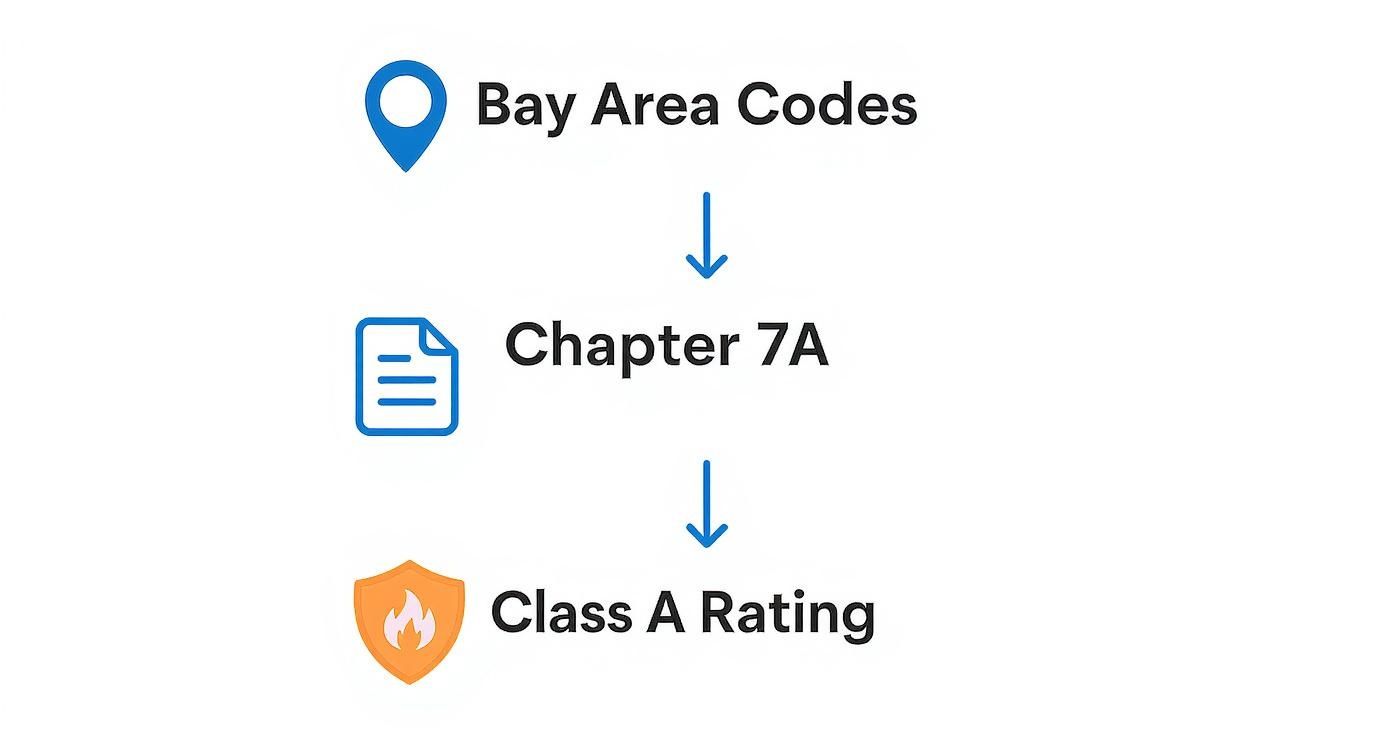
For homes in high-risk zones, Chapter 7A of the California Building Code makes it clear: a Class A rating is the non-negotiable goal.
Building Safer Decks and Outdoor Spaces
Decks are often the first part of a home to ignite during a wildfire. They can trap embers underneath and are usually built with combustible wood. A fire-smart deck starts with choosing the right materials for the surface and structure.
Composite decking with fire-retardant materials is a popular choice. It looks like wood but has better durability and fire resistance. Other options include lightweight concrete pavers or stone patios, which create a non-combustible zone next to your home.
Windows and Doors: The Critical Barriers
Windows and doors can be serious weak points. The intense heat from a wildfire can shatter standard glass and ignite wooden frames. This gives flames a direct path into your home.
Modern, high-performance windows are engineered to prevent this.
The standard for WUI zones is dual-pane windows, with at least one pane made of tempered glass. Tempered glass is much stronger than standard glass and withstands higher temperatures without breaking.
For frames, materials like fiberglass and aluminum-clad wood offer better fire resistance than all-vinyl or solid wood. They resist warping and melting under heat. This helps maintain a tight seal to keep embers and flames out.
This simple table outlines common material choices and their protective benefits.
Fire-Resistant Material Options for Bay Area Homes
| Building Component | Material Example | Typical Fire Rating | Primary Protective Benefit |
|---|---|---|---|
| Roofing | Metal, Clay Tile, Class A Asphalt Shingles | Class A | Prevents ignition from airborne embers. |
| Siding | Fiber Cement, Stucco, Brick Veneer | 1-Hour Rating | Resists direct flame and radiant heat. |
| Decking | Fire-Retardant Composite, Stone Pavers | Class A / Class B | Creates a non-combustible zone near the home. |
| Windows | Dual-Pane with Tempered Glass | WUI-Rated | Resists breakage from heat, preventing flame entry. |
| Gutters | Steel, Copper, Aluminum | Non-Combustible | Won't melt or ignite, preventing fire spread up eaves. |
Making smart material choices is one of the most powerful steps you can take to protect your home and family. Each component works together to create a cohesive defense system.
How Fire Resilience Boosts Your Property Value
Choosing fire-resistant materials is a smart investment in your property's future. While safety is the primary goal, the long-term financial benefits are just as real. These upgrades improve your home's financial health from several angles.
When you choose materials that last longer and need less upkeep, you make a savvy financial decision. This is a huge part of building for tomorrow. This approach transforms a house into a more durable, insurable, and valuable asset.
Lower Insurance Premiums
Insurance companies in California are on high alert. They use mapping tools to pinpoint a property's wildfire vulnerability. Homes with combustible materials often face higher premiums or may be denied coverage.
When you upgrade to fire-resistant materials, you lower your home's risk profile to an insurer.
- Demonstrable Risk Reduction: Installing Class A roofing, fiber cement siding, and tempered glass windows gives an insurer proof you have mitigated potential losses.
- Potential for Significant Savings: Many carriers offer discounts for homes with certified fire-resistant features. These savings can add up to thousands of dollars over time.
- Improved Insurability: In parts of the Berkeley and Oakland hills, a "hardened" home can make securing a policy possible.
This proactive approach makes your property more attractive to insurers and more affordable to own.
Higher Resale Value in a Competitive Market
Bay Area homebuyers are savvier and more safety-conscious than ever. A home built to withstand a wildfire is a premium product that commands a higher price tag. In this market, resilience has become a powerful selling point.
A fire-hardened home signals quality, durability, and smart design. Reports from the National Association of Realtors show that homes with features that protect against climate risks are in high demand. That demand translates to a better sale price.
A resilient home is a smart investment that appreciates over time. Buyers are willing to pay more for the peace of mind that comes with a property built with durable, fire-resistant materials.
Durability and Reduced Maintenance Costs
Fire-resistant materials also offer an immediate return through durability and lower maintenance. Many of these products are engineered to stand up to fire and the Bay Area's diverse microclimates.
Consider these long-term advantages:
- Fiber Cement Siding: This material resists rot, pests, and moisture damage far better than wood, which means less frequent repainting or repairs.
- Metal Roofing: A quality metal roof can last 50 years or more. This compares to the 20-year lifespan of a standard asphalt shingle roof.
- Composite Decking: It won't splinter, warp, or rot. This saves you the annual cost and labor of sanding and re-staining a wood deck.
These benefits slash the total cost of ownership over the years. For more ideas on upgrades, check our guide on which types of home renovations boost value. Choosing fire-resistant materials is a powerful way to secure your investment.
Achieving Beautiful Design with Safe Materials
Let's clear up a common myth: building for safety does not mean sacrificing style. Homeowners and architects in the Bay Area often worry that fire-resistant materials will create a boxy, industrial look.
But that couldn't be further from the truth. Modern fire-smart materials are made with both beauty and versatility in mind. They come in a massive range of textures, colors, and finishes to elevate your home's design.
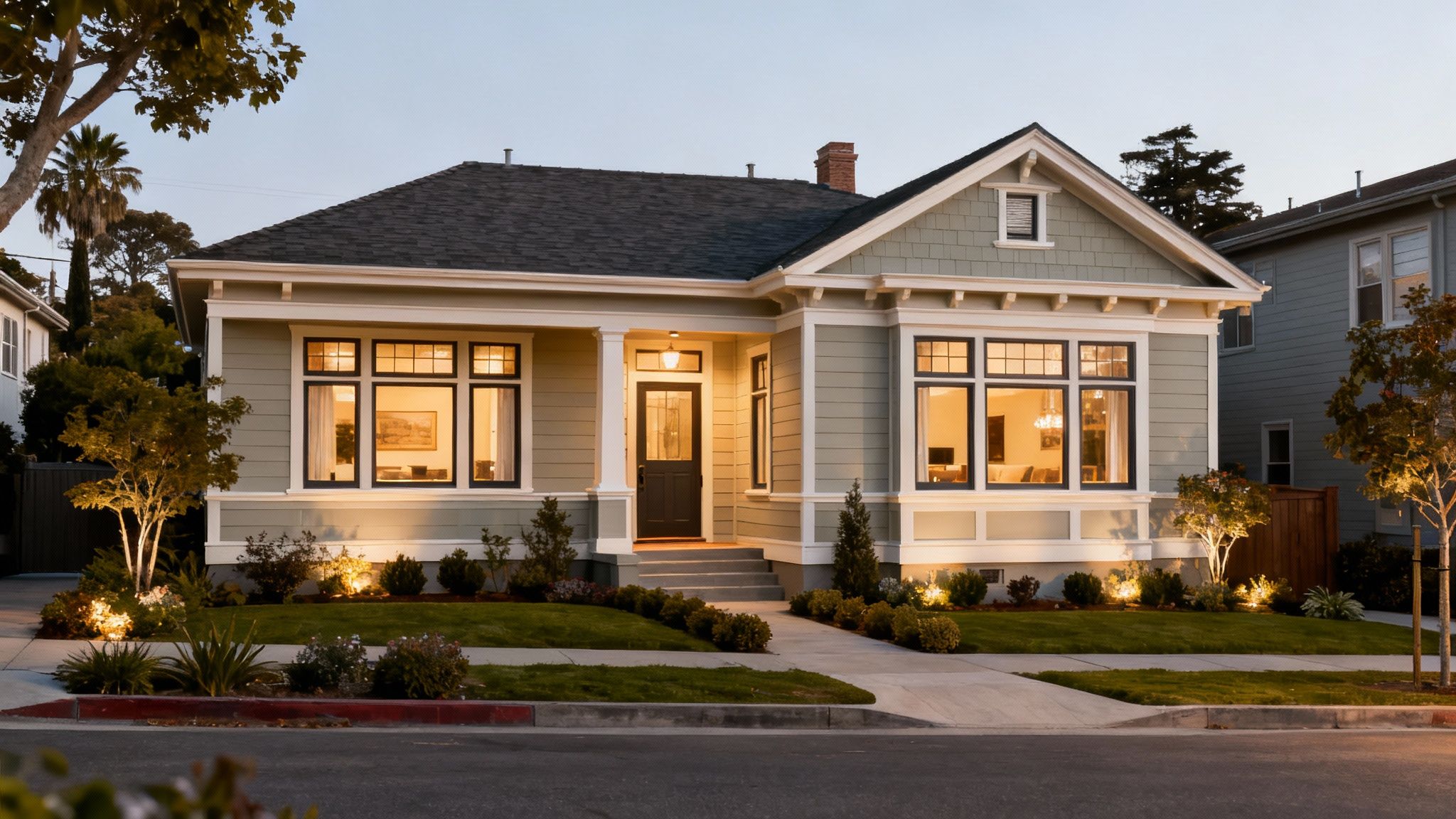
Blending Safety with Bay Area Styles
Whether you're restoring a classic Berkeley craftsman or designing a modern home in the Oakland hills, there are compliant options. It’s all about knowing which products deliver both top performance and aesthetic appeal.
Today’s best manufacturers have perfected the art of imitation. You can have the warm look of natural wood or the clean lines of stucco without the fire risk.
- Fiber Cement Siding: Brands like James Hardie have mastered the rich texture of wood grain in a non-combustible product. It comes in styles from classic lap siding to modern panels and can be painted any color.
- High-Performance Windows: The days of bulky safety windows are gone. Companies like Marvin and Andersen offer elegant, WUI-rated windows with slim profiles and beautiful wood interiors. You get tempered glass protection without sacrificing natural light.
- Fire-Retardant Composites: Modern composite decking gives you the look of exotic hardwoods but won't ignite from embers. This creates beautiful, functional, and safe outdoor living spaces.
A Cohesive and Elegant Defense
The goal is to create a home that is seamlessly beautiful and safe. By integrating these advanced materials, your property becomes visually striking and resilient. Explore more about combining design with durability in windows and doors in our detailed guide.
Great design solves problems elegantly. In the Bay Area, one of the biggest problems is wildfire risk. Using beautiful, fire-resistant materials is simply smart, responsible design.
Pairing a sleek metal roof with wood-look fiber cement siding creates a contemporary aesthetic that is also a Class A-rated fortress. Large, tempered-glass windows frame your views while providing a barrier against heat. It’s about making smart choices that prove your home’s safety can be its most beautiful feature.
Your Partner in Building a Resilient Bay Area
Building a home that can stand up to fire is a major project, but you don’t have to do it alone. The big picture is clear: understanding your risks and choosing the right materials are crucial for building for tomorrow. This is about creating a safer place to live.
The proof is in the numbers. Modern fire-resistant materials dramatically cut down on risks. According to the National Fire Protection Association, the fire death rate per 1,000 fires was 70% lower in properties with fire sprinklers. Better materials and systems save lives. You can read more analysis on how modern buildings provide superior fire protection.
With our deep expertise in Bay Area codes and our inventory of high-performance materials, we’re here to help. We can give you the guidance you need to make confident decisions.
Let's work together to build a safer future for your home and community. Connect with our experts today to get your project started.
Frequently Asked Questions About Fire-Resistant Building
Moving to fire-resistant materials brings up questions for homeowners and contractors. Whether you’re building a new home in Oakland or hardening a bungalow in Berkeley, it pays to have the facts. We've put together some clear answers to common questions.
Our goal is to cut through the confusion. We want to give you the confidence to make fire-safe construction a straightforward choice for your project.
Are fire-resistant materials more expensive?
Some fire-resistant materials have a higher upfront cost. But it’s an investment in your home’s future. These materials often lead to long-term savings from durability, less maintenance, and potential discounts on your homeowner's insurance. A fire-hardened home also has great resale appeal in the Bay Area.
Do I need these materials if I'm not in a WUI zone?
Even if your property isn't in a Wildland-Urban Interface (WUI) zone, using fire-resistant materials is a smart move. Embers from a major wildfire can travel for more than a mile. Homes in dense, urban neighborhoods are still at risk from a nearby blaze. These upgrades provide a critical layer of defense and peace of mind.
Can I retrofit my existing Bay Area home?
Yes, retrofitting is an effective way to "harden" your home against fire. Key projects include replacing old wood siding with fiber cement, installing a Class A-rated roof, and upgrading windows to dual-pane, tempered glass. Our team can help you identify which upgrades will make the biggest impact on your home's safety.
How do I know which materials meet local codes?
Navigating Bay Area building codes can be difficult. The surest bet is to work with experts who deal with these local requirements daily. The team at Truitt & White is familiar with California's Chapter 7A building code. We can point you to compliant lumber, siding, and windows for your project.
What is the most important upgrade for fire resistance?
Experts agree that the roof is the single most vulnerable part of a house. Its large surface is a perfect landing spot for embers to ignite. Upgrading to a Class A fire-rated roofing material is one of the most critical steps you can take. Protecting exterior vents with fine metal mesh screens is another low-cost, high-impact fix to block embers from entering your attic.
At Truitt & White, we're here to help you build a safer, more resilient home. We have the deep local knowledge and premium materials you need to protect what matters most. Stop by our Berkeley showroom or connect with our specialists for advice tailored to your project.


